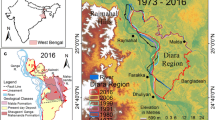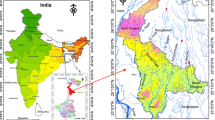Abstract
Harike wetland in the Indian state of Punjab is formed by a barrage built downstream on the confluence of rivers Satluj and Beas, with the idea of storing and providing irrigation and drinking water to parts of Southern Punjab and adjoining Rajasthan. Due to decrease in flow at Harike and deforestation etc. in the catchment area, the wetland is reducing in the last few years. In this study, the analysis of rainfall/runoff data has been carried out to see the effect of decreasing trend of runoff on wetland area. Wetland area has been delineated using remote sensing technique. The analysis of rainfall, discharge and ground water level showed that the flow pattern is decreasing at Harike. The remote sensing data revealed that the wetland area has reduced approximately 30% over the last 13 years.
Similar content being viewed by others
References
Alsdorf DE, Smith LC, Melack JM (2001) Amazon floodplain water level changes measured with interferometric SIR-C radar. IEEE Trans Geosci Remote Sens 39(2):423–431
Anonymous (1990) Wetlands of India – a directory. Ministry of Environment & Forest, Govt. of India, New Delhi
Bourgeau-Chavez LL, Kasischke ES, Brunzell SM, Mudd JP, Smith KB, Frick, AL (2001) Analysis of space-borne SAR data for wetland mapping in Virginia riparian ecosystems. Int J Remote Sens 22(18):3665–3687
Chopra R, Verma VK, Sharma PK (2001) Mapping, monitoring and conservation of Harike wetland ecosystem, Punjab, India, through remote sensing. Int J Remote Sens, 22(1):89–98
Gopal B (1994) Role of ecotones in conservation and management of tropical inland waters. Mitt Int Verein Theor Angew Limnol 24:17–25
Jerath N (1992) The environs and problems of Harike wetland; some strategies for conservation. In: Chatrath KJS (ed) Wetlands of India. Ashish, New Delhi, India, pp 103–124
Lunetta R, Balogh M (1999) Application of multi-temporal landsat 5 TM imagery for wetland identification. Photogramm Eng Remote Sensing 65(11):1303–1310
MacKinnon F (2001) Wetland application of LIDAR data: analysis of vegetation types and heights in wetlands, 44 p. Applied Geomatics Research Group, Centre of Geographical Sciences, Nova Scotia
Majumdar PK, Kumar S, Singh RD, Jain SK, Sarkar A (2004) Regional ground water modeling in Satluj Beas basin in Central Punjab. Project report, National Institute of Hydrology
McFeeters SK (1996) The use of normalised difference water index (NDWI) in the delineation of open water features. Int J Remote Sens 17(7):1425–1432
Mitsch WJ, Gosselink JG (2000) Wetlands, 3 edn. Wiley, New York
Neural Power (2003) Neural network professional version 2.5 CPC-X Software, Copyright: 1997–2003 http://www.geocities.com/neuralpower/)
Ramachandra TV (2001) Restoration and management strategies of wetlands in developing countries. Electron Green J 15:1–15 (December)
Rio JNR, Lozano-Garcia DF (2000) Spatial filtering of radar data (RADARSAT) for wetlands (brackish marshes) classification. Remote Sens Environ 73:143–151
Shaikh M, Green D, Cross H (2001) A remote sensing approach to determine environmental flows for wetlands of the Lower Darling River, New South Wales, Australia. Int J Remote Sens 22(9):1737–1751
Shepherd I, Wilkinson G, Thompson J (2000) Monitoring surface water storage in the north Kent Marshes using Landsat TM Images. Int J Remote Sens 21(9) 1843–1865
Töyrä J, Pietroniro A, Martz LW (2001) Multisensor hydrologic assessment of a freshwater wetland. Remote Sens Environ 75:162–173
Water and Power Consultancy Services (India) Limited (WAPCOS) (1996) Operation of Bhakra and Pong reservoirs during flood and other flood mitigation measures. Final report (May)
Zhu M, Fujita M, Hashimoto N (1994) Application of neural networks to runoff prediction. In: Hipel KW et al. (eds) Stochastic and statistical method in hydrology and environmental engineering, vol. 3, pp 205–216. Kluwer, Dordrecht
Author information
Authors and Affiliations
Corresponding author
Rights and permissions
About this article
Cite this article
Jain, S.K., Sarkar, A. & Garg, V. Impact of Declining Trend of Flow on Harike Wetland, India. Water Resour Manage 22, 409–421 (2008). https://doi.org/10.1007/s11269-007-9169-9
Received:
Accepted:
Published:
Issue Date:
DOI: https://doi.org/10.1007/s11269-007-9169-9




